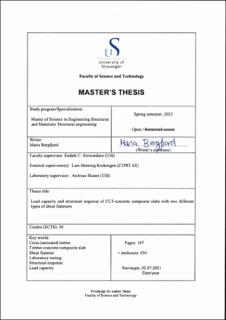| dc.contributor.advisor | Siriwardane, Sudath C. (UiS) | |
| dc.contributor.advisor | Krokengen, Lars Henning (COWI AS) | |
| dc.contributor.advisor | Skaare, Andreas (UiS) | |
| dc.contributor.author | Bergfjord, Maria | |
| dc.date.accessioned | 2021-10-01T16:26:16Z | |
| dc.date.available | 2021-10-01T16:26:16Z | |
| dc.date.issued | 2021 | |
| dc.identifier | no.uis:inspera:78873759:9073501 | |
| dc.identifier.uri | https://hdl.handle.net/11250/2787108 | |
| dc.description.abstract | Abstract
The subject of this Master thesis is to investigate the performance of the behaviour of Cross Laminated Timber-concrete composite slabs with two different types of shear fasteners by performing theoretical predictions and a laboratory testing, through a four-point bending test.
The type of shear fasteners is of high importance in structural design of a Timber-Concrete Composite (TCC) structure. The shear fasteners join the two elements together and the aim of the TCC is to work as one element, fully composite action. The TCC structure generally acts partially composite and this motivate to further examine the efficiency of different shear fasteners and their arrangement to achieve fully composite action of the TCC slabs. For this thesis two types of shear fasteners were examined: type A, CTC screws using crossed parallel and arranged in angles of 45o and steel mesh reinforcement and type B using KOP screws oriented in pairs with a 45o angle.
Theoretical predictions are performed using a combination of the γ- method and the shear analogy method to find the load capacity and maximum deflections for Cross Laminated Timber (CLT)-concrete composite slabs, both types A and B, are performed before conducting the laboratory tests. These theoretical predictions were then compared with the laboratory test results. Additional theoretical calculations were then performed, to check if it was possible to predict the failure load of the test more precisely. The degree of composite action was also examined by determining the efficiency of the shear fasteners was also examined. The efficiency can be found through the relationship of the theoretical calculations and measured deflection at midspan for a timber beam and concrete slab.
The result obtained from laboratory testing demonstrated that slabs of type A could withstand a much higher applied load than slabs of type B. These results showed that slabs of A had a much more conservative theoretical prediction, while that slabs of type B were very similar to the theoretical predicted result. Various of limitations might have had an influential factor on the results for both theoretical predictions and the laboratory testing. Hence, further studies should be performed to make a definite conclusion of the chosen shear fasteners. | |
| dc.description.abstract | | |
| dc.language | eng | |
| dc.publisher | uis | |
| dc.title | Load capacity and structural response of CLT-concrete composite slabs with two different types of shear fasteners | |
| dc.type | Master thesis | |
